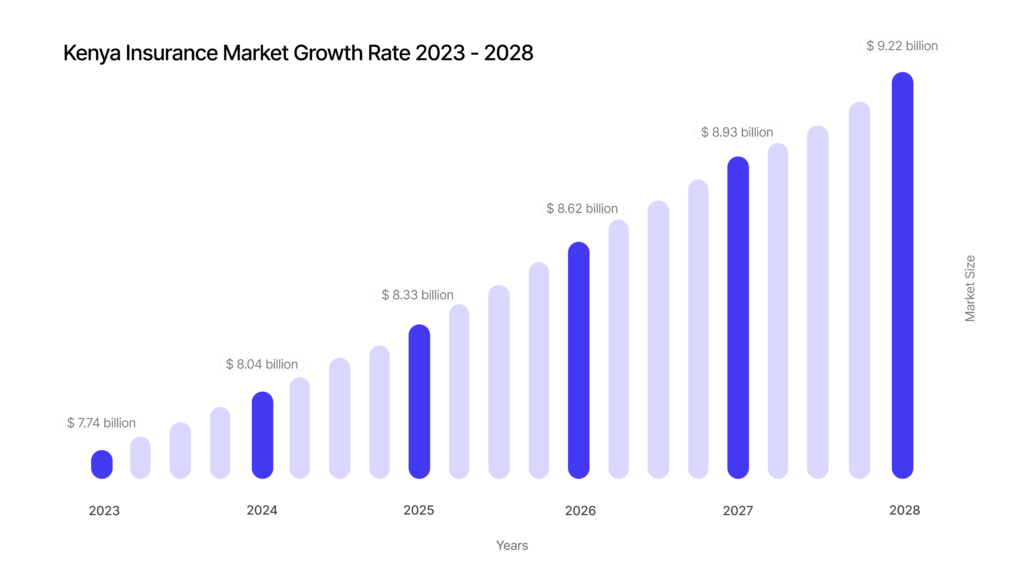
Have you ever felt like buying insurance was like walking a tightrope? You are not alone. Because of insufficient information, insurance decisions in Kenya are frequently filled with uncertainty. But do not be afraid! Our blog serves as a beacon in the storm, shedding light on the state of insurance today and what lies ahead.
In this blog we will discuss the changing landscape of insurance in Kenya, exploring trends, innovations, and strategies which insurance companies will be focussing for a strong future.
The current state of insurance in Kenya
Looking to get insurance in Kenya? You are in luck! The insurance industry is booming, with a diverse range of coverage options. Everyone can find something for themselves, from property and health insurance to auto and business policies. If you want to be extra safe, you can even get life insurance.
Despite the industry’s expansion, only a small proportion of Kenyan households own formal insurance policies. This is primarily due to high premium costs and low public awareness of its benefits.
But there’s hope for improvement! Major insurance companies, including Jubilee Insurance and UAP Old Mutual, are investing in infrastructure and outreach programs, indicating potential growth opportunities. So, even if insurance isn’t currently on your radar, it’s something to keep an eye on.
Challenges facing the insurance industry in Kenya
The future of insurance in Kenya holds promise, but it’s not without its challenges. Despite being home to numerous insurance companies, the industry faces hurdles that need addressing.
Firstly, there’s the issue of low financial literacy among Kenyans. With only 40% understanding insurance concepts, it’s tough for companies to gain traction.
Limited internet access further complicates matters. While Kenya boasts a large population, only around 32 million have internet access, limiting the reach of online insurance services.
Additionally, the lack of customer data hampers product development. Without accurate information, tailoring plans to meet customer needs is challenging.
Though obstacles exist, the potential for growth remains high. Major insurers are investing in infrastructure and outreach, signaling optimism for the future.

Exploring the changing face of insurance in Kenya
The insurance landscape in Kenya is undergoing a remarkable transformation, fueled by rapid advancements in technology and shifting consumer preferences. Traditional insurance norms are being challenged as the industry embraces innovative trends, paving the way for a dynamic future.
Here are some key trends shaping the evolution of insurance in Kenya:
1. Insurtech revolution: The rise of cutting-edge technologies such as artificial intelligence (AI) and blockchain is revolutionizing how insurance services are delivered. This enables insurers to offer tailored policies and streamline processes, meeting the evolving needs of customers more effectively.
2. Modernized infrastructure: Kenya is making significant investments in infrastructure development, setting new industry standards, and enhancing data accessibility. This modernization drive empowers insurers with better insights, fostering greater trust among customers and enabling more robust risk management practices.
3. Expanding customer base: With initiatives promoting financial inclusion and a tech-savvy youth population, Kenya’s insurance market is witnessing rapid expansion. This growing customer base, coupled with a demand for digital solutions, positions Kenya as one of Africa’s burgeoning insurance hubs.
In this era of transformation, Kenyan insurers are poised to embrace innovation and cater to the diverse needs of their clientele, driving the industry towards a more inclusive and digitally driven future.
Opportunities for growth in Kenya’s insurance Sector
In Kenya, the insurance industry is poised for remarkable growth and development, driven by favorable economic conditions and progressive regulatory frameworks. This presents a plethora of opportunities for insurers to expand their reach and enhance their offerings to meet the evolving needs of customers.
Here’s a glimpse of the promising avenues for growth in Kenya’s insurance sector:
1. Market expansion: With rising competition, insurers are incentivized to explore new markets and diversify their product portfolios. This strategic expansion enables them to tap into a broader customer base, driving long-term growth and profitability.
2. Technological innovation: Embracing innovative technologies such as mobile banking, AI, and blockchain holds immense potential for insurers to optimize operations, enhance customer experiences, and offer tailored solutions. Leveraging these advancements fosters efficiency gains and strengthens competitiveness in the digital era.
3. Education initiatives: Investing in financial literacy programs and educational initiatives empowers insurers to raise awareness about insurance products and their benefits among the populace. By fostering a culture of informed decision-making, insurers can foster greater trust and engagement with customers.
The impact of technology on Kenya’s insurance landscape
In Kenya, technology is revolutionizing the insurance landscape, paving the way for unprecedented efficiency, accessibility, and customer-centricity. From automation and AI to innovative product offerings, technology is reshaping the insurance experience in profound ways.
Here’s how technology is driving change in Kenya’s insurance sector:
1. Automation and AI: Automation streamlines cumbersome processes like claims processing, accelerating service delivery and enhancing customer satisfaction. AI-powered insights enable insurers to assess risks more effectively and tailor solutions to individual needs, driving operational efficiency and risk management.
2. Innovative products: Technological advancements have facilitated the emergence of innovative insurance products, catering to niche needs such as cyber coverage and micro-insurance. These offerings empower individuals and businesses to access tailored solutions that mitigate specific risks, fostering financial resilience and inclusivity.
3. Digital authentication: Biometric authentication technologies enable seamless and secure access to insurance services, eliminating paperwork and enhancing customer convenience. By leveraging digital authentication methods, insurers can streamline onboarding processes and enhance fraud prevention measures, ensuring a seamless and secure customer experience.
The regulatory landscape shaping Kenya’s insurance future
In Kenya, regulatory frameworks play a pivotal role in shaping the trajectory of the insurance industry, safeguarding consumer interests, and fostering market stability. With evolving regulations and compliance requirements, insurers must navigate a dynamic landscape to adapt and thrive in an increasingly regulated environment.
Here’s how the regulatory framework is shaping the future of insurance in Kenya:
1. Compliance imperatives: Stringent regulatory standards mandate insurers to adhere to compliance requirements, ensuring transparency, accountability, and consumer protection. Compliance measures mitigate operational risks and bolster market integrity, fostering trust and confidence among stakeholders.
2. Market conduct oversight: Regulatory authorities exercise oversight to monitor insurers’ market conduct and ensure adherence to ethical standards and fair practices. Robust supervision mechanisms safeguard against malpractices, promoting market efficiency and enhancing consumer trust.
3. Innovation facilitation: Regulatory frameworks that promote innovation and market competition incentivize insurers to innovate and diversify their offerings. Flexible regulatory approaches encourage experimentation and foster a conducive environment for technological advancements and product innovation.
As Kenya’s insurance sector evolves, regulatory frameworks will continue to evolve in tandem, balancing industry dynamism with consumer protection and market stability. Adapting to regulatory changes and embracing a culture of compliance will be critical for insurers to thrive in the evolving landscape.
Conclusion
In conclusion, Kenya’s insurance sector is on the brink of significant advancement, yet there remains ample opportunity for further growth. With strategic policy implementations and regulatory enhancements, the nation stands poised for a prosperous future in insurance. As the proverbial saying goes, the real test lies in the outcomes, and Kenyan insurers are gearing up to deliver promising results. While the journey ahead may present challenges, there is optimism for progress and innovation.







